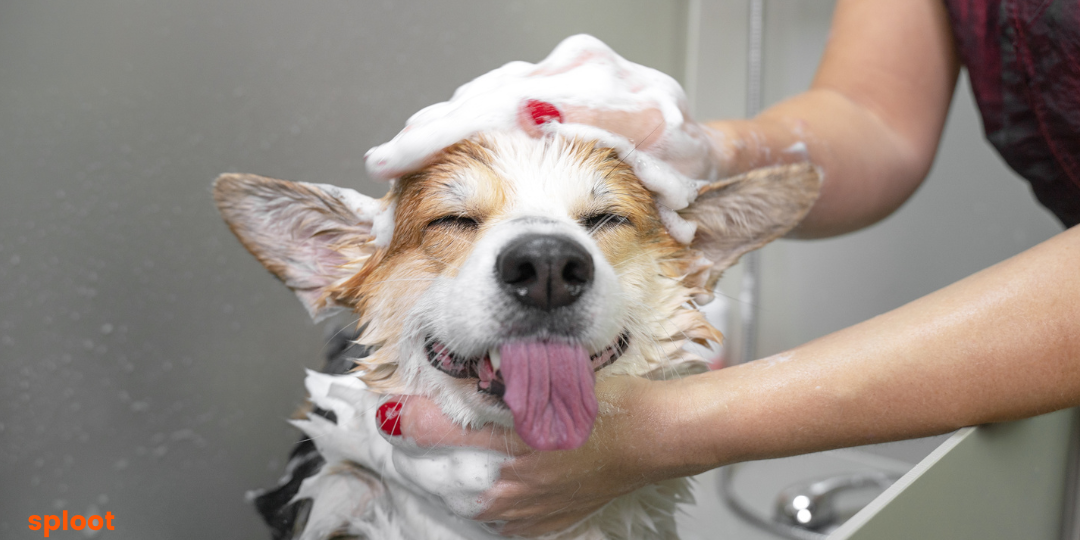Dog Grooming 101: Getting Your Pup Used to Being Groomed

Regular dog grooming is an essential part of keeping your canine companion looking and feeling their best. However, the process of getting groomed can understandably feel stressful or scary for many dogs, especially puppies experiencing it for the first time. With some patience and positive reinforcement, you can help get your pup used to being groomed and make those visits to the dog groomer a fun, non-traumatic experience.
Why Is Dog Grooming Important?
Before we dive into tips for dog grooming your pup at home, let's go over some key reasons why grooming is so important for their health and wellbeing:
- Prevents matting and tangles in the fur, avoiding painful mats close to the skin
- Trims overgrown nails to prevent cracking, splitting, or painful ingrown nails
- Cleans out dirt, dander, and excess fur to promote healthy skin and coat
- Checks for any lumps, bumps, or abnormalities during brushing
- Reduces shedding around the home by removing loose fur
- Gives you bonding time and a chance to look over your pup's body
- Helps your pup get used to being handled from an early age
- Keeps your dog looking (and smelling!) their very best

Even if you work with a professional dog groomer, it's still a good idea to get your dog comfortable with basic grooming like brushing, teeth brushing, and nail trims at home. This will make your regular grooming appointments go much smoother for both of you.
Start Grooming Training Early
It's best to get your puppy used to being groomed from a very young age if possible. Introduce grooming tools and activities like brushing very gradually using positive reinforcement training. This will help prevent fear and anxiety from developing around grooming.
Use tasty, pup-approved treats to reward calm, relaxed behavior and make grooming a fun game of sitting still for nibbles. Getting your puppy comfortable being handled and touched all over their body during these training sessions will pay off big time down the road.
If adopting an older dog who hasn't had much grooming exposure, go slowly and don't force any activities they seem uncomfortable with. This may require enlisting the help of a professional groomer or trainer to desensitize and build positive associations with grooming.
How to Get a Dog Used to Brushing
Regular brushing helps keep your pup's coat free of mats and tangles. It's a good idea to get dogs used to being brushed from an early age by making it a fun, positive experience. Here are some tips for brushing success:
- Use a grooming table, counter, or raised surface to avoid bending over
- Keep brushing sessions short and super positive - just 2-3 minutes
- Start by brushing an area your dog doesn't seem sensitive about
- Work up to fully brushing their legs, paws, tail, ears, belly, etc.
- Use a detangler spray, brush spray, or conditioner to prevent tangles
- Give your dog a treat and praise for calm, relaxed behavior while brushing
- End the session on a positive note before your dog gets too wiggly

Start getting dogs used to having their paws, ears, tail, and face touched and brushed very gently while offering treats and praise. Getting pups comfortable being handled all over is key for safe, stress-free grooming.
Introducing Nail Trims Early
Nail trims are an essential part of dog grooming to prevent cracked, overgrown nails and torn nails causing pain and bleeding. However, the sound and sensation of clippers can understandably startle and scare many dogs. Here's how to get your pup used to nail trims:
- Hold your puppy's paw while giving treats to get comfortable
- Let them sniff, lick, and get used to the sight and sound of clippers
- Gently touch clippers to a single nail while treating for being still
- Clip one nail at a time while rewarding calm behavior
- Be very careful not to clip the "quick" (blood vessel) of the nail
- Give your dog a break if they get overly squirmy or distressed
- Tire your dog with play before attempting - a tired pup is calmer
Getting regular, frequent nail trims from a young age will help immensely with making this grooming task less stressful for you both.
Bathing and Ear Cleaning Tips
Baths are another component of dog grooming that tends to be disliked by many of our canine pals. Thankfully, you can get dogs used to water, shampoo, and getting ears cleaned by following some simple bathing tips:
- Brush your dog thoroughly before bathing to remove excess fur
- Use a pitcher, pitcher, or detachable sprayer to control water flow
- Have a bath mat or non-slip surface to prevent sliding and fear
- Use lukewarm water and dog-friendly shampoo/conditioner
- Lift long ears gently and clean ears with a dog-safe solution
- Allow your pup to lick a dog-safe peanut butter treat while bathing
- Provide plenty of towels, treats, and praise for being a good bather!
Take it slowly when introducing bathing. Don't force your pup into the tub or water if they seem very scared. Use a lick mat or stuff a toy with treats to keep them occupied. Make it an overwhelmingly positive, relaxed experience.
Dealing With Mats and Tangles
No matter how often you brush, stubborn mats and tangles happen, especially with long-haired breeds. While you may be tempted to try cutting through tough knots with scissors, this puts your pup at serious risk of getting accidentally nicked by the blades.

Instead, use a dog grooming mat splitter, mat rake, or comb specifically designed to humanely break apart matted fur. You can also try applying a detangling solution and gently working through the mat with your fingers. Start mat removal while your pup is in a calm, relaxed state with treats on hand.
For large, severe matting, it may be best to visit a professional groomer who can safely shave out those pesky knots with grooming clippers. Preventing mats in the first place is ideal through diligent brushing, especially for long-coated breeds.
Don't Forget About Teeth!
Part of a whole-body grooming routine for dogs includes regular tooth brushing. Getting your pup used to having their mouth and teeth handled will make life much easier when it comes to dental cleanings and inspections at the veterinarian's office.
Start slowly by touching your pup's muzzle, lips, and teeth while treating for calm behavior. You can even let them lick a dog-safe toothpaste off your finger at first. Then work up to very gently brushing with a soft toothbrush and lots of praise and rewards.
Signs You May Need Professional Grooming Help
Sometimes, despite your best efforts at home, you may need to enlist the help of a professional dog groomer for more complicated grooming needs like:
- Removing severely matted fur safely
- Trimming sensitive areas like paws, face, and sanitary areas
- Giving breed-specific haircuts like Poodle clips
- Thorough de-shedding and deshedding treatments
- Proper coat hand-stripping for show dogs
- Anally expressing glands (if your dog requires it)
- Other specialized show/breed grooming needs
Look for an experienced groomer you trust who makes safety their top priority. Ask about their training, certifications, and experience level. Dog groomers should be skilled at properly restraining dogs and making them feel at ease.

